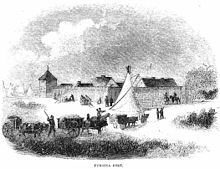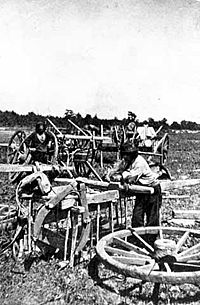Pembina, North Dakota
Pembina, North Dakota | |
|---|---|
 Building and water tower in Pembina | |
 Location of Pembina, North Dakota | |
| Country | United States |
| State | North Dakota |
| County | Pembina |
| Area | |
| • Total | 0.8 sq mi (2.0 km2) |
| • Land | 0.8 sq mi (2.0 km2) |
| • Water | 0.0 sq mi (0.0 km2) |
| Elevation | 778 ft (237 m) |
| Population | |
| • Total | 592 |
| • Density | 843.1/sq mi (325.5/km2) |
| Time zone | UTC-6 (Central (CST)) |
| • Summer (DST) | UTC-5 (CDT) |
| ZIP code | 58271 |
| Area code | 701 |
| FIPS code | 38-61580Template:GR |
| GNIS feature ID | 1030666Template:GR |
Pembina (/[invalid input: 'icon'][invalid input: 'pembina-nd.ogg']ˈpɛmbɪnə/) is a city in Pembina County, North Dakota in the United States. The population was 592 at the 2010 census.[1]
Pembina is the oldest community in the Dakotas.[2] A fur-trading post was established on the site of present-day Pembina in 1797 and the first permanent European settlement started in 1812.[2] Until 1823, Pembina was thought to be in Canada, but in that year United States Army Major Stephen H. Long's survey of the 49th parallel revealed Pembina's location south of the Canada – United States border.[3]
The first United States post office in present-day North Dakota was established in Pembina in 1851.[4] Pembina served as county seat from 1867 to 1911. It is near the northern end of Interstate 29 at the Canada-United States border at Emerson, Manitoba. It is a significant crossing for road traffic headed to and from Winnipeg, Manitoba, and is one of three 24-hour ports of entry in North Dakota (the others are Portal and Dunseith).
Pembina is home to the U.S. satellite plant of Motor Coach Industries, which completes assembly of intercity buses. Its major clients include Greyhound Lines.
History
The Pembina area was historically at the borders of the territories of the Sioux, the Chippewa and the Assiniboine, Native American tribes, who competed for hegemony over the territory. Their conflict increased beginning with the French introduction of firearms in the late 16th century. The first known European visitors to the Pembina region were the French Vérendrye family in the early 18th century.
Pembina's recorded history of European encounter extended for more than 200 years. Started by the French as a fur trading post for commerce with the Native Americans, it was also tied to trade for American Bison. European trappers who hunted in the Red River of the North area frequently married Indian women and often lived with local tribes at least part of the year. Their mixed-race descendants became part of their hunting and trapping culture, and formed the later ethnic group recognized as Métis people. The settlement was associated with the histories of French Canada, Hudson's Bay Company, the Selkirk Colony, Seven Oaks Massacre, the Red River Rebellion, Assiniboia, and Manitoba. Through much of the nineteenth century, Métis families used the two-wheeled Red River ox cart trains to travel into the Great Plains, where the men would hunt bison and women would process the meat, skins and bones. All parts were used for clothing, tepees, etc. Their regular routes became known as the Red River Trails. This area was part of the United States Dakota and Minnesota territories; and border politics.
The noted American author Louise Erdrich has represented the Pembina River and the Pembina Band of the Ojibwe Indians on the Turtle Mountain Reservation in numerous works of fiction. Only in the past few years have the Pembina recognized their unique heritage.
Despite its small size - as noted in the chart at right no census has ever shown its population exceeding 1,000 - Pembina nonetheless maintained a television station, KCND-TV, from 1960 to 1975.
Fort Pembina

Due to the unrest among Native Americans of the Red River Valley after the American Civil War, the Minnesota Legislature petitioned Congress to build a fort, especially to defend against incursions by the Sioux, who had been driven into Canada. As a result, Major General Winfield Scott Hancock recommended the establishment of the post on December 8, 1869 and Fort Pembina was completed on July 8, 1870. Located a mile and a half south of the settlement, it was just above the mouth of the Pembina River. It was originally called Fort Thomas, for Major General George H. Thomas, who died on March 28, 1870. The post was designated Fort Pembina on September 6, 1870. Seriously damaged by fire on May 27, 1895, it was abandoned on August 16, 1895. It was later sold at public auction.[5]
Geography
Pembina is located at 48°57′59″N 97°14′43″W / 48.96639°N 97.24528°WInvalid arguments have been passed to the {{#coordinates:}} function (48.966423, -97.245142),Template:GR at the confluence of the Red River of the North and the Pembina River. The city of St. Vincent, Minnesota lies adjacent to the east, across the Red River.
According to the United States Census Bureau, the city has a total area of 0.8 square miles (2.0 km²), all of it land.
Pembina experiences a humid continental climate (Köppen Dfb) with long, dry, very cold winters and very warm, wetter summers.
| Climate data for Pembina, ND | |||||||||||||
|---|---|---|---|---|---|---|---|---|---|---|---|---|---|
| Month | Jan | Feb | Mar | Apr | May | Jun | Jul | Aug | Sep | Oct | Nov | Dec | Year |
| Record high °F (°C) | 48 (9) |
61 (16) |
75 (24) |
99 (37) |
98 (37) |
100 (38) |
101 (38) |
104 (40) |
101 (38) |
93 (34) |
78 (26) |
53 (12) |
104 (40) |
| Mean daily maximum °F (°C) | 11.5 (−11.4) |
19.3 (−7.1) |
31.7 (−0.2) |
51.5 (10.8) |
67.9 (19.9) |
75.6 (24.2) |
79.7 (26.5) |
79.1 (26.2) |
67.9 (19.9) |
53.5 (11.9) |
32.5 (0.3) |
17.5 (−8.1) |
49.0 (9.4) |
| Daily mean °F (°C) | 1.2 (−17.1) |
8.6 (−13.0) |
21.9 (−5.6) |
39.5 (4.2) |
54.5 (12.5) |
63.0 (17.2) |
66.9 (19.4) |
65.1 (18.4) |
54.4 (12.4) |
41.6 (5.3) |
23.5 (−4.7) |
7.9 (−13.4) |
37.3 (3.0) |
| Mean daily minimum °F (°C) | −9.2 (−22.9) |
−2.1 (−18.9) |
12.1 (−11.1) |
27.5 (−2.5) |
41.1 (5.1) |
50.4 (10.2) |
54.1 (12.3) |
51.1 (10.6) |
40.8 (4.9) |
29.7 (−1.3) |
14.4 (−9.8) |
−1.7 (−18.7) |
25.7 (−3.5) |
| Record low °F (°C) | −48 (−44) |
−42 (−41) |
−39 (−39) |
−12 (−24) |
9 (−13) |
25 (−4) |
34 (1) |
29 (−2) |
18 (−8) |
0 (−18) |
−39 (−39) |
−40 (−40) |
−48 (−44) |
| Average precipitation inches (mm) | 0.44 (11) |
0.40 (10) |
0.72 (18) |
0.99 (25) |
2.09 (53) |
3.41 (87) |
2.95 (75) |
2.68 (68) |
2.12 (54) |
1.48 (38) |
0.85 (22) |
0.45 (11) |
18.58 (472) |
| Source 1: NOAA (normals, 1971-2000) [6] | |||||||||||||
| Source 2: The Weather Channel (Records) [7] | |||||||||||||
Demographics


| Census | Pop. | Note | %± |
|---|---|---|---|
| 1880 | 287 | — | |
| 1890 | 670 | 133.4% | |
| 1900 | 929 | 38.7% | |
| 1910 | 717 | −22.8% | |
| 1920 | 802 | 11.9% | |
| 1930 | 551 | −31.3% | |
| 1940 | 703 | 27.6% | |
| 1950 | 640 | −9.0% | |
| 1960 | 625 | −2.3% | |
| 1970 | 741 | 18.6% | |
| 1980 | 673 | −9.2% | |
| 1990 | 642 | −4.6% | |
| 2000 | 642 | 0.0% | |
| 2010 | 592 | −7.8% | |
As of the censusTemplate:GR of 2000, there were 642 people, 250 households, and 177 families residing in the city. The population density was 843.1 people per square mile (326.2/km²). There were 274 housing units at an average density of 359.8 per square mile (139.2/km²). The racial makeup of the city was 96.57% White, 0.16% African American, 0.47% Native American, 0.47% Asian, 1.56% from other races, and 0.78% from two or more races. Hispanic or Latino of any race were 1.87% of the population.
There were 250 households out of which 35.2% had children under the age of 18 living with them, 62.8% were married couples living together, 5.2% had a female householder with no husband present, and 28.8% were non-families. 26.8% of all households were made up of individuals and 11.2% had someone living alone who was 65 years of age or older. The average household size was 2.57 and the average family size was 3.12.
In the city the population was spread out with 29.4% under the age of 18, 4.8% from 18 to 24, 29.0% from 25 to 44, 24.0% from 45 to 64, and 12.8% who were 65 years of age or older. The median age was 37 years. For every 100 females there were 98.8 males. For every 100 females age 18 and over, there were 105.0 males.
The median income for a household in the city was $55,536, and the median income for a family was $59,722. Males had a median income of $35,250 versus $26,125 for females. The per capita income for the city was $20,278. About 4.5% of families and 7.7% of the population were below the poverty line, including 12.1% of those under age 18 and 8.2% of those age 65 or over.
Sites of interest
- Pembina State Museum - interpretative exhibits commemorating establishment of Pembina in 1797 as the earliest settlement in what is now the state of North Dakota.
Notes
- ^ a b "2010 Census Redistricting Data (Public Law 94-171) Summary File". American FactFinder. United States Census Bureau. Retrieved 2 May 2011.
- ^ a b History of Pembina - City of Pembina website
- ^ [1] Where is Pembina? - Prairie Radio website
- ^ Chronological history of North Dakota - State Historical Society
- ^ Forts in the Dakota Territory, Frohne & Son Historic Military, Accessed December 8, 2010
- ^ "Climatography of the United States NO.81" (PDF). National Oceanic and Atmospheric Administration. Retrieved January 16, 2011.
- ^ "Monthly Averages for Pembina, ND". The Weather Channel. Retrieved January 16, 2011.
External links
- City of Pembina official website
- History of Pembina - city website


